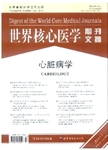经导管房间隔缺损封堵术后心肌肌钙蛋白的释放依赖于封堵器的大小并非患者的年龄
Cardiac troponin I release after transcatheter atrial septal defect closure depends on occluder size but not on patient's age作者机构:Dr. Department of Paediatric CardiologyHeart Centre University of Leipzig Strümpellstrasse 39 04289 Leipzig Germany
出 版 物:《世界核心医学期刊文摘(心脏病学分册)》 (Digest of the World Core Medical Journals(Cardiology))
年 卷 期:2005年第1卷第7期
页 面:30-31页
学科分类:1002[医学-临床医学] 100201[医学-内科学(含:心血管病、血液病、呼吸系病、消化系病、内分泌与代谢病、肾病、风湿病、传染病)] 10[医学]
主 题:封堵器 心肌肌钙蛋白 封堵术 经导管封堵 免疫测定法 血清心肌 外科手术 肌损伤 介入性 释放量
摘 要:Objective: To examine whether transcatheter closure of secundum atrial septal defect(ASD) with the Amplatzer septal occluder leads to more myocardial injury in children than in adults. Design: In a prospective study with children and adults cardiac troponin I(cTnl) serum concentrations were determined by immunoassay(AxSYM, Abbott Laboratories) before, during, and up to 20 months after surgical or transcatheter ASD closure. Patients: Four groups of patients were studied: transcatheter ASD closure(group 1: 22 children, age range 3.26-14.7 years; group 2: 22 adults, 18.0-67.3 years), surgical ASD closure(group 3:18 children, 3.12-13.5 years), and diagnostic catheterisation(group 4: 12 children, 2.68-15.0 years). Results: cTnl concentrations were significantly increased after occluder implantation with higher serum concentrations in children than in adults(immediately after implantation: group 1, 3.2(4.4)-μg/l; group 2, 1.1(4.2) μg/l; four hours after implantation: group 1, 4.8(5.0) μg/l; group 2, 1.7(2.3) μg/l; both p 0.01, group 1 v group 2; one day after implantation: group 1, 3.0(5.7) μg/l; group 2, 2.2(5.2) μg/l) but were less than 20%of those after surgical ASD closure(group 3; p 0.001) where the highest cTnl concentration was found(37.1(26.3) μg/l). Diagnostic catheterisation(group 4) was not associated with detectable cTnl increase. From the cTnl concentrations the total amount of cTnl released after ASD closure was estimated for each patient. This was dependent on the size of the occluder(p 0.05) but not on the patient’s age or procedural duration. Conclusion: In regard to interventional ASD closure our data do not provide evidence that the child’s myocardium is more vulnerable. Transcatheter ASD closure induces minor myocardial lesion, the extent of which depends on the size of the Amplatzer septal occluder but is irrespective of the patient’s age.



